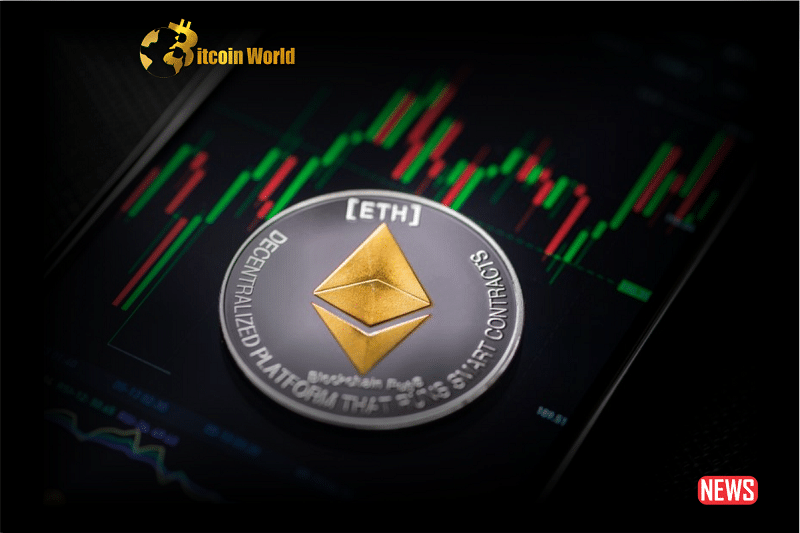The crypto market can feel like a rollercoaster, and Ethereum (ETH) has certainly seen its share of ups and downs. After hitting an 11-month high, the price has cooled off a bit, currently hovering around $1,900. But don’t let the short-term fluctuations fool you. Many analysts are still incredibly bullish on ETH’s medium to long-term potential, especially when you stack it up against other major players like Bitcoin. What’s the secret sauce? It boils down to powerful deflationary forces working behind the scenes.
Why is Everyone Talking About Ethereum’s Deflation?
Think of it like this: when something becomes more scarce, its value tends to increase. Ethereum has a unique setup that’s designed to do just that – make ETH tokens less readily available over time. This scarcity can act as a powerful tailwind, potentially pushing prices higher in the future. Unlike some other cryptocurrencies with fixed supplies, Ethereum’s supply mechanics are dynamic and influenced by network activity and user participation.
The Double Whammy: Two Deflationary Forces at Play
Ethereum isn’t relying on just one deflationary mechanism; it has two powerful forces working in its favor:
- The Increasing Deflation Rate: Imagine a shrinking pie. That’s essentially what’s happening with the ETH supply. A key factor is the burning of ETH used for transaction fees. When network activity is high, more ETH gets burned, permanently removing it from circulation. This shrinking supply can create significant upward pressure on the price.
- The Staking Surge: Think of staking as locking up your ETH in a digital vault to help secure the Ethereum network. In return, you earn rewards, kind of like interest. The recent “Shapella” upgrade was a game-changer, allowing investors to withdraw their staked ETH for the first time since staking began on the Beacon Chain in December 2020. You might think this would lead to a mass exodus of staked ETH, right? Wrong!

The Staking Paradox: More Locking, Less Available
Instead of withdrawing, investors are actually staking their ETH at an even faster pace! The amount of ETH being deposited into staking contracts is outpacing the withdrawal limit (50,400 ETH per day), leading to new all-time highs in the amount of ETH being staked. This might sound counterintuitive, but it’s a testament to the confidence investors have in Ethereum’s long-term prospects and the attractive yields staking offers.
What Does This Mean for the ETH Price?
As more and more ETH gets locked away in staking contracts, the amount of readily available ETH on exchanges decreases. This reduced supply, coupled with continued or increasing demand, can create a supply squeeze, potentially driving the price upwards. Think of it like this:
| Factor | Impact on ETH Supply | Potential Impact on Price |
|---|---|---|
| Increased Staking | Decreases available supply | Increases price due to scarcity |
| ETH Burning (Transaction Fees) | Permanently reduces total supply | Increases price due to scarcity |
Could Staking Participation Reach New Heights?
Currently, a significant portion of ETH is already staked, but there’s still room for growth. If the staking participation rate climbs to the 40-50% range in the coming years, as some analysts predict, the impact on the available supply could be substantial. Imagine a scenario where nearly half of all ETH is locked up, earning rewards and unavailable for immediate trading. This level of scarcity could be a major catalyst for price appreciation.
The Burn Rate: Another Catalyst for Deflation
Don’t forget about the burn rate! As the Ethereum network sees more usage and transaction fees rise, the amount of ETH being burned increases. This permanently removes ETH from circulation, further contributing to the deflationary pressure. It’s a self-reinforcing cycle: higher network activity can lead to more burning, which in turn can lead to increased scarcity and potentially higher prices.
Navigating the Crypto Landscape: Is ETH a Smart Long-Term Bet?
While the recent price dip might cause some short-term jitters, the underlying fundamentals for Ethereum remain strong. The combination of increasing staking participation and the ETH burning mechanism creates a compelling deflationary narrative. Of course, like any investment, there are risks involved. Macroeconomic conditions, regulatory changes, and competition from other blockchain platforms can all influence ETH’s price. However, the deflationary tailwinds provide a strong argument for its long-term potential.
Key Takeaways:
- Deflationary Powerhouse: Ethereum benefits from two key deflationary mechanisms: increased staking and ETH burning.
- Staking Surge: The Shapella upgrade hasn’t led to a mass unstaking; instead, more ETH is being locked up.
- Supply Squeeze: Increased staking reduces the readily available supply of ETH, potentially driving up prices.
- Burn Rate Matters: Higher network activity can lead to more ETH being burned, further enhancing scarcity.
- Long-Term Potential: Despite short-term volatility, the deflationary forces make ETH an attractive option for long-term investors.
Looking Ahead: The Future of ETH and Deflation
The journey of any cryptocurrency is rarely a straight line. There will be periods of excitement and periods of consolidation. However, the unique deflationary characteristics of Ethereum, driven by staking and the burn mechanism, position it favorably for potential long-term growth. As the supply of ETH becomes increasingly scarce, the fundamental principles of supply and demand suggest that its value could appreciate significantly. While no one can predict the future with certainty, the deflationary narrative surrounding Ethereum is a compelling reason for optimism among long-term investors.
Disclaimer: The information provided is not trading advice, Bitcoinworld.co.in holds no liability for any investments made based on the information provided on this page. We strongly recommend independent research and/or consultation with a qualified professional before making any investment decisions.


